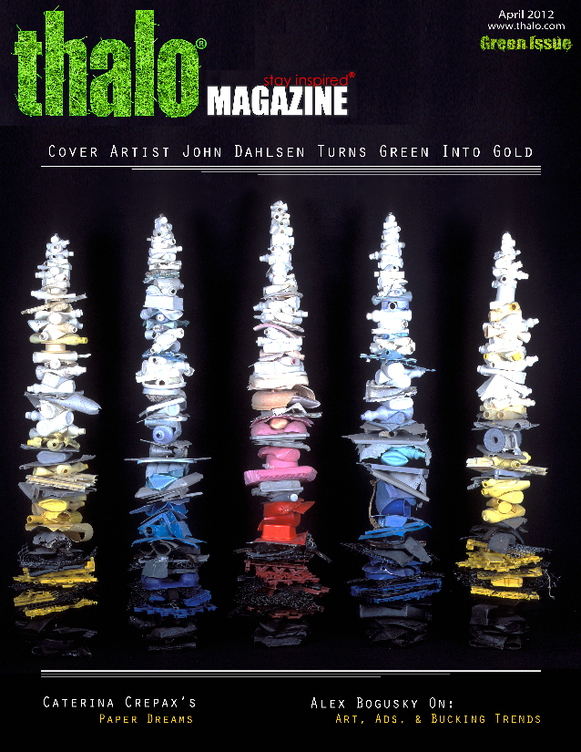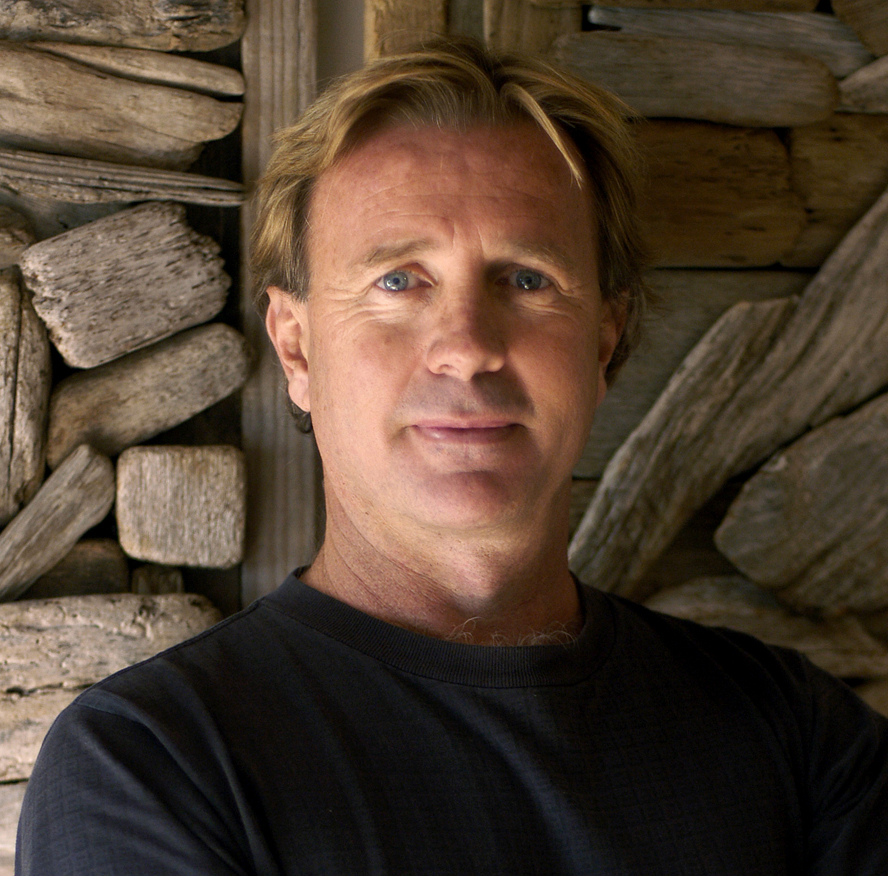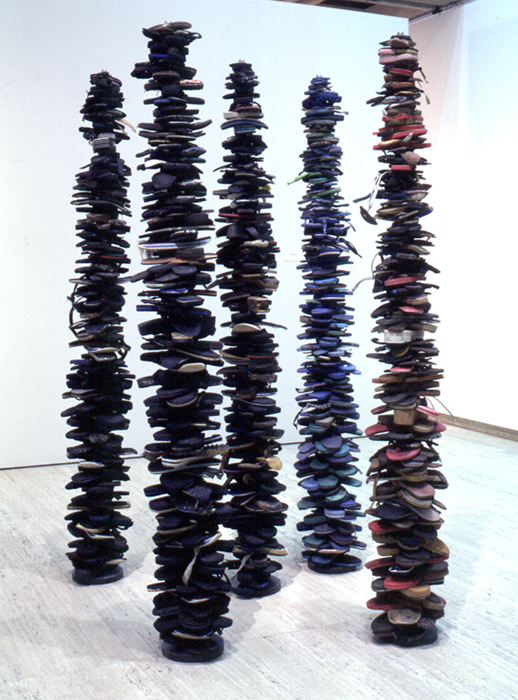
 April Cover ArtistCover Artist: John Dahlsen
April Cover ArtistCover Artist: John Dahlsen 


“John Dahlsen isn’t your average artist. A bold statement to make but appropriate after you realize the sheer depth and determination which goes into the work this man has produced over the past seven years. Although he has been within art circles for much longer than that, it is only in the most recent years, which have seen Dahlsen create a different form of art with environmental messages and strong statements. It is ‘found’ object art, be that organic or inorganic. He would be seen scavenging beaches in search of plastics, specific colours and sizes. He is also known for venturing along the edge of Victoria alone in search of driftwood. Boat trips, four-wheel-drive tours and scaling 40 meter-high cliffs, were all part of the process for this driftwood exhibition and Dahlsen admits at times there were death-defying moments grabbing the perfect piece of wood.”
thalo: How did you get interested in environmental art?
John Dahlsen: My creative medium shifted from painting to working with found objects as a result of an artistic accident during the mid 1990’s. I was collecting driftwood, on a remote Victorian Coastline, with the intention of making furniture and stumbled upon vast amounts of plastic ocean debris. This whole new palette of colour and shape revealing itself to me immediately affected me; I’d never seen such hues and forms before. Since then for approximately 15 years, I scoured Australian beaches for found objects, much of which I found as washed up ‘ocean litter’. As I worked with these objects, I became even more fascinated by the way they had been modified and weathered by the ocean and nature’s elements. My challenge as an artist was to take these found objects, which might on first meeting have no apparent dialogue, and to work with them until they speak and tell their story, which included those underlying environmental messages inherent in the use of this kind of medium. My work is in a constant state of evolution. I see this largely as alchemical. It is the process of nature’s elements redefining the man-made that creates the initial alchemy in working with these found objects, taking the objects beyond the mundane. The second step was achieved through the transportation of these plastics to my studio and the process of sorting and assembling. A further and more vital transformation took place as I assembled them. These found objects then started to tell their story and become transformed into artworks.
th: Can you tell us a bit about your piece Primary Totems? Why was it necessary for you to sort them by color?
JD: : Primary Totems is a further example of my artwork making a difference to people's perception. I’m sharing a positive message about beauty that can be gained from the aesthetic experience of appreciating art, as well as giving example with this work of beauty in the use of the primary colours delicately presented, ascending from dark to light and of how we can recycle and reuse in creative ways. This artwork exemplifies my commitment as an artist to express contemporary social and environmental concerns. By presenting this art to the public, it will hopefully have people thinking about the deeper meaning of the work, in particular the environmental issues we currently face. I hope this work will act as a constant reminder to people about awareness. I would like them to find enjoyment of the work on many levels and find themselves becoming identified in various ways with each of the artworks they see, when they view my work
th: : As an artist who works with ocean debris, found objects, and things generally considered “trash” do you come across resistance from others who claim this type of work isn’t truly “art”?
JD: In the early days when I first presented my assemblages in exhibitions at the end of the 90s, there was some limited resistance by a few, as I seemed to challenge their perceptions, but by now this has changed significantly. I think it’s great that many artists are now highlighting strong environmental issues in their work such as climate change. I believe we need all the help we can get at the moment and if art can help shift people's awareness in a positive direction, then great. In all honesty, I see the real need for massive social transformations. They are essential, to adequately deal with such crises as the depletion of fossil fuels and climate change. I hope that my own work can be a timely reminder to us about climate change and of the limited supply of petroleum based materials, which is a direct result of our current collective global mass consumerism. In the same way, I hope that the viewing public also embraces the messages, which other sincere artists are conveying with their work particularly when they are expressing strong environmental statements intelligently and with a high degree of aesthetic complexity.
th: What do you hope that people come away from your pieces thinking about?
JD: I see that by making this art, it is a way of sharing my messages for the need to care for our environment with a broad audience. I feel that even if just a fraction of the viewing audience were to experience a shift in their awareness and consciousness about the environment and art, through being exposed to this artwork then it would be worth it. The present direction in my environmental art work which also incorporates sculpture (I am also working on some recycled tree stump sculptures as well at the moment), and assemblage, is a natural evolution for me and further consolidates my return to painting, which was my main medium for many years, prior to my working for over 8 years with found objects; making sculptures and assemblages from beach found plastic litter, which were largely based upon environmental artist themes, taking society's discarded objects of the everyday and transforming them into formal compositions
th: You also work with driftwood, metal, and paints, to name a few. Do you find yourself drawn to one medium over another, or is the chosen medium just a reflection of what feels right for the project?
JD: Mostly the chosen medium is just a reflection of what feels right for the project. I have worked with so many mediums over the years with my environmental art. At one point, apart from working with beach found plastics I also developed new works using recycled plastic bags as the primary medium, “Blue River” is one of my most well known works using this medium. This work was a finalist in the 2003 Wynne prize at the Art Gallery of NSW Australia. My recycled plastic bag artwork is a departure from the more recognizable assemblage works in which I used plastics and other detritus collected from the Eastern seaboard, “Thong Totems” which won the Wynne Prize in 2000 being a good example. With this recycled plastic bag work, apart from wishing to express obvious environmental messages, I have been particularly interested in the brilliance of the colours and textures available to me in working with this medium. I am constantly surprised to see the variations in these plastics, very much like how I am intrigued by the beach found objects I have collected over the years. The most recent example of my working in this medium was in 2005, when I was artist in residence at Jefferson City Missouri, USA. Here I made a series of totemic installations with thousands of plastic bags in clear acrylic tubes for their sculpture walk. I imagine these plastic bags, which mostly have a lifespan of many years, are possibly facing extinction, as governments are beginning to impose deterrents to people using them. In the mean time I am able as a contemporary visual artist, to use these recycled materials, to create artworks which, I hope express a certain beauty, as well as containing their own unique environmental messages
To see more of John Dahlsen's work visit www.johndahlsen.com.
permalink | past covers
